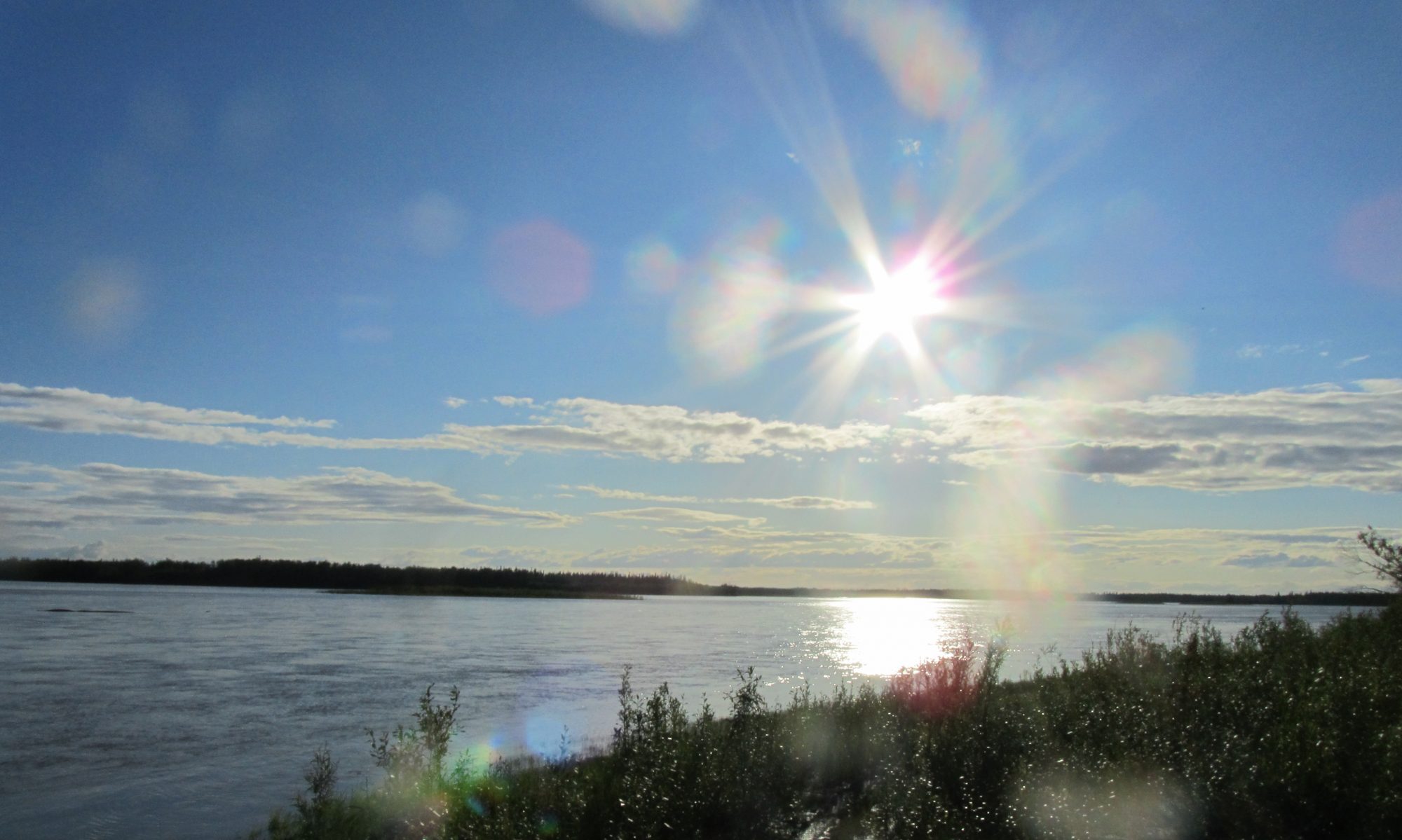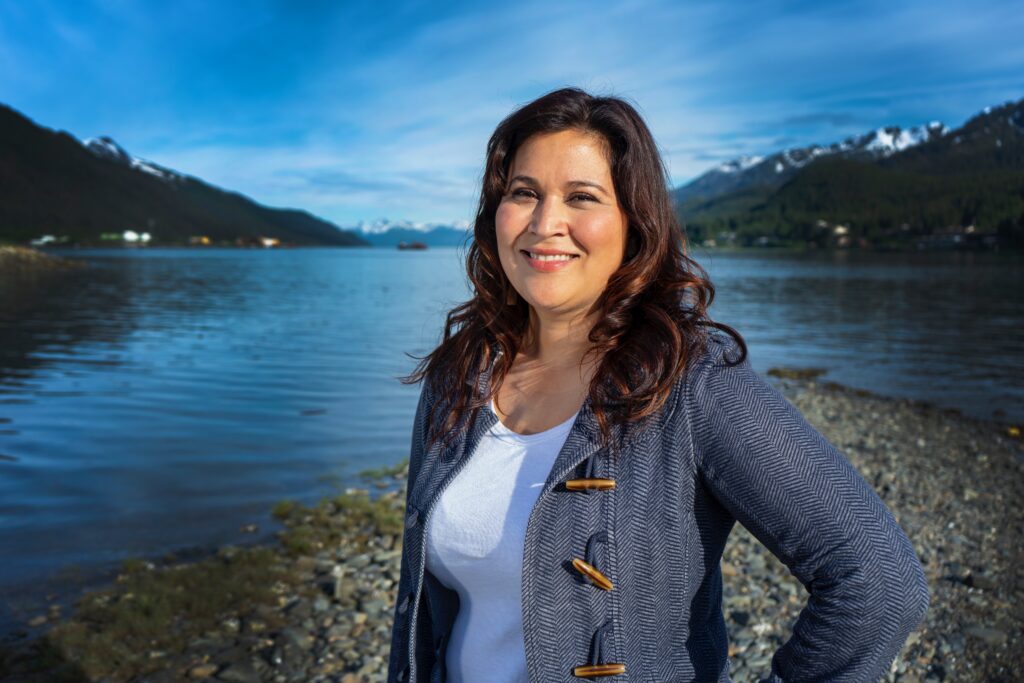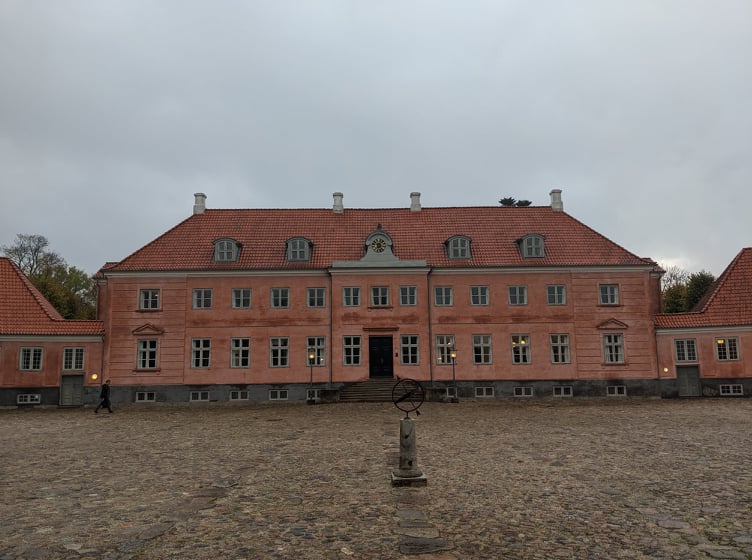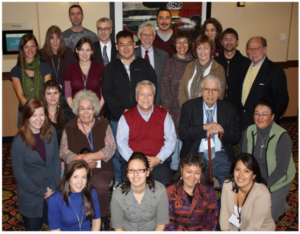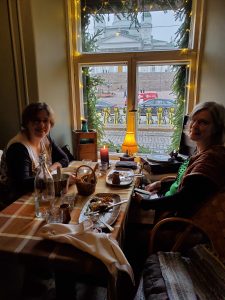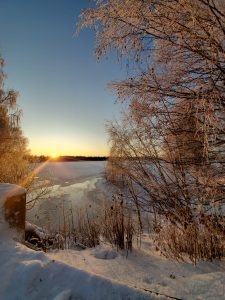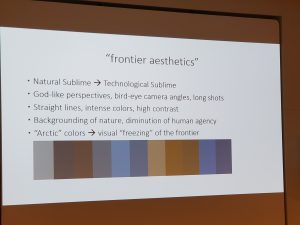ANCSA changed the lives of everybody in Alaska. Whether you are Alaska Native, non-Native, or some “other” kind of Native as I am, your life has been affected by ANCSA if you have spent any length of time at all in the state. Alaska would not look the way it looks today were it not for the Act and the Corporations it created. ANCSA is woven throughout everything that happens in the state today and we cannot really understand what is going on unless we understand ANCSA.
Now for a disclosure, I am not an ANCSA shareholder. I am however an example of some of the many ways that non-shareholders have benefited from the legislation. I have a number of relatives and many friends who are shareholders. I have been a scholar of the Act for a long time and I want to say “thank you” to all of those whose hard work made ANCSA possible.
ANCSA marked the beginning of a new chapter in my life. The very first class I ever took at UAF was an Alaska Native Studies course about ANCSA. This was in 1999 and, for the next 22 years, I would study ANCSA from every imaginable angle. Subsistence, law, the Doctrine of Christian Discovery, economics, finance, land management, tribal law, climate change, culture, ANCSA was always there. ANCSA guided my studies through 3 different degree programs. It provided me with the backdrop for all of my studies in Rural Development, and international indigenous law. Jobs with three different Regional Corporations helped me pay my way through school. I would go on to teach courses on the Act, and continue to study it today. I could not have had the successful academic career that I enjoyed without the help of ANCSA.
As I learned about the land claims period during the 1960s I was struck by how easily those who were fighting to protect the land could have failed. Their cause was not popular in Alaska which had a significant non-Native population that opposed any form of settlement. My study of territorial history found anti-Native racism so deeply embedded as to be invisible to much of the population that were perpetuating it.[1] A settlement was never a given. The men and women who fought for it are to be commended for succeeding against incredible odds. And we must remember that what they got was an Act of Congress, not a treaty or a negotiated settlement. It was not perfect but it was the best they could get: a tool to be used for the future. And an amazing achievement given what they were up against!
The 1990s/early 2000s was an exciting time to be a part of the Rural Development program at UAF. Through coursework, guest speakers and seminars, students had the incredible privilege of meeting many of the amazing people who, through hard work and sacrifice, had made ANCSA happen. Dr. Emil Notti, Dr. Willie Hensley, Dr. Gordon Pullar, Miranda Wright, Fred Bigjim, Jim LaBelle, Dixie Dayo, Darlene Wright, Alfred Ketzler Sr. and many others. Some are gone now: John Borbridge, Senator John Sackett, Dr. Walter Soboleff, Byron Mallott, Alice Petrivelli, Charles Etok Edwardson Jr, but they shared their wisdom before they left us. These were people who played active parts in the land claims movement of the 1960s and then the implementation of the Act that followed. They gave generously of their time and encouraged us all to continue our studies and I for one am very grateful for their input.
It did not take long however for me to see that not everything in the ANCSA rose garden was perfect. As I became more assimilated into the Alaska Native community I realized that all was not well. I attended an unreasonable number of funerals. I comforted far too many friends who had lost children to suicide and accidents. There was poverty in many communities along with a lack of basic developments like water and sewer systems and responsive law enforcement. The State had unreasonably high levels of drug and alcohol abuse and I became very aware of the extreme levels of violence and sexual assault that persisted. In 2013 the Indian Law and Order Commission deemed public safety to be such a concern in rural Alaska that they devoted an entire chapter of their Report to Alaska.[2]
Unemployment and homelessness rates were disproportionately high for Alaska Natives throughout the State. In many villages, unemployment topped 50% and what jobs there were skewed towards “government work” indicating a lack of private investment. Incarceration rates were also disproportionate and I observed some blatantly unjust court decisions that harmed Alaska Natives. I personally experienced the biased justice system on more than one occasion.
I learned that tribal governments had been omitted from ANCSA leaving them with very little in the way of resources to provide governance in their communities. I saw that there was often little in the way of partnership between ANCs and Tribes even though they served the same population. Tribes lacked the kind of territorial jurisdiction they needed to provide effective governance. Not everyone agreed about the kinds of development that were needed and who should pay for them.
There was active war ongoing between Tribes and the State of Alaska. The state of Alaska was spending large amounts of money disputing with tribes over the most basic parts of tribal sovereignty. These protracted legal battles consumed limited funds and energy from Tribes that could have been better spent in their communities. The state was spending public money to fight against its own citizens at the same time that it cried poor when asked to fund services in their communities.[3]
Today, subsistence continues to be a legal battle field. At least 60 disputes regarding subsistence went through the court systems during ANCSA’s first 50 years. And there are more coming. The extinguishment of aboriginal hunting and fishing rights in section 4(b) of ANCSA[4] has never been resolved in a way that worked for Alaska Native communities and the cost has been huge for everyone involved.
I understood then why some of the people I met were not happy with ANCSA and said that ANCSA was intended to terminate their very existence. Clearly there was still more work to be done. How might these conditions be improved?
Do I think that all the shortcomings I have noted are solely the fault of ANCSA? No, of course not. there is far more to it than that. For instance, Congress could have passed legislation to correct the subsistence problems it failed to correct within Title 8 of the Alaska National Interest Lands Conservation Act (ANILCA).[5] The State could have worked to develop subsistence law that would withstand legal challenge, perhaps learning from Hawaii’s Constitution.[6] The State of Alaska could have long since chosen to recognize Tribes and partner with them instead of fighting expensive court battles. There was nothing in ANCSA that forbade better working relationships between ANCs and Tribes. If the State had been able to meet its obligations in terms of law enforcement in the villages we would not be in the unenviable position of having our own chapter in the Indian Law and Order Commission’s Report. Obviously ANCSA was not the sole culprit but it did include a mandate to address “the real economic and social needs of Natives,”.[7] Could it actually do this? Were there tools hidden within the Act that were not being fully utilized and/or content that could be further amended that would go a long way to addressing some of the complaints.
The next 50 years.
When the Dawes General Allotment Act was passed in 1887 there was an expectation that assimilation would be complete within twenty-five years and Lower 48 Indian lands would become available to non-Indian buyers.[8] (This was supposed to benefit Indians both economically and socially). Things did not work out that way. Millions of acres of Indian lands were lost, and tribes were impoverished, and it has taken over 100 years for some Lower 48 tribes to recover while for others the work is still in progress. Those tribes did not give up, they did not just let go, and they used all the tools available to them to survive, but it took another Act of Congress, the Indian Reorganization Act in 1934, to slow the destruction. ANCSA has only been around for 50 years so, before we wonder why everything is not yet perfect, we might compare where we are now with where Lower 48 tribes were 50 years after the Dawes Act. Alaska Natives have been using the tools, and in some areas the progress has been remarkable. Other areas still need work but we are in a much better place than the Lower 48 was 50 years after the Dawes Act.
When we look at the wording of the original ANCSA it seems remarkable that we are celebrating the 50th birthday. It was not intended to be this way. Hidden away in Section 7 was the following termination language:
“Sec. 7. (h)(3) On January 1 of the 21st year after the year in which this Act is enacted, all stock previously issued shall be deemed to be canceled, and shares of stock of the appropriate class shall be issued without restrictions required by this Act to each stockholder share for share.”[9]
This language would have removed all the restrictions on the ANCSA shares after 20 years and placed them on the open market at which time they could have been freely sold by the Native shareholders, and bought by anybody who wished to participate. If this would’ve happened we can be sure that the landscape would look very different today and it would not have been positive for Alaska Native cultural continuity. Thanks to the “1991 Amendments”[10] the shares remain in restricted status today. The statute looks very different now and readers are encouraged to compare the original Section 7 with its update in the U.S. Code.[11]
It is tempting to take the position that because this sunset clause was amended to protect the Native ownership of the corporations, there is nothing more to worry about and we can simply move on. If we look carefully though, this is not the case. There have been numerous amendments to ANCSA but, most of these involve property rights. With the exception of these amendments, we still have a piece of legislation that has been in place for 50 years that was originally crafted around speedy assimilation if not outright termination. There are still many of the parts of ANCSA that are not working well in terms of the social and economic well-being of Alaska Natives today which can be traced back to the expectation of speedy assimilation and the understanding by Congress that Section 7 (h)(3) would be implemented.
Shareholder Continuity: If Sec. 7 (h)(3) had not been amended enrollment would have not been an issue after 1991. Thirty years later continuing enrollment is very important if the ANCs are to continue their work. ANCSA was amended to allow shareholders from each Corporation to vote to issue shares to Natives born after the December 18th 1971 cut off date. To date, six Alaska Native Corporations (ANCs) and some Alaska Native Village Corporations (ANVCs) have voted to do this.[12]
Blood quantum requirements are often raised as a complaint about ANCSA but these were actually addressed in the 1991 Amendments. Section 2, Definitions, now includes:
“(r) “Descendant of a Native” means
- a lineal descendant of a Native or of an individual who would have been a Native if such individual were alive on December 18, 1971, or (2) an adoptee of a Native or of a descendant of a Native, whose adoption (A) occurred prior to his or her majority, and (B) is recognized at law or in equity;”[13]
Shareholders can vote to enroll “new Natives” using linear descent rather than blood quantum, but only a couple of the ANCs (ASRC and Calista) have chosen to do this.[14] So, shareholders do have an option to vote to both enroll new Natives, and to remove the blood quantum requirement if they so choose. There are tools there to insure shareholder continuity if Corporations and shareholders want to use them however there could be future downsides to eliminating the blood quantum requirement that would need to be considered. If, for instance, a large percentage of current shareholders reside out of state as indicated in a 2012 GAO report,[15] their children who would qualify to be shareholders via lineal descent might have little or no connection to the land and see no reason to retain it in the future.
Tribal governance: ANCSA was silent on tribal governance in spite of having been presented by some as self-determination legislation. The Native leadership pursuing land claims could only do so much. Their primary focus was on securing the land. The omission of provisions for governance was unexpected. In Alaska Native Rights, Statehood, and Unfinished Business, Robert Anderson states:
“It is understandable that Native leadership at the time would not have seriously considered that settlement of land claims necessarily diminished the authority of Native tribal governments. There were over 70 villages organized under the Indian Reorganization Act at the time, and most others operated under some form of traditional council governance.”[16]
Why did Congress ignore these governments? ANCSA’s failure to provide for self-governance speaks to the reality of the legislation as a property rights settlement, as well as to how Tribes were viewed in Alaska in 1971. Whatever the thinking may have been 50 years ago, it is now time to correct this and support the Tribes so that they can provide better governance. While in theory, a Village Corporation can convey some (or even all) of its land to a Tribe, this may not be the best solution. It leaves the land without the protections against alienation that ANCSA provides, and the Tribe may or may not be able to place that land into trust to gain Indian Country status and regain the protections.
It is up to Tribes and Corporations to come together and decide what they want for the next 50 years. There is no one size fits all so amending ANCSA cannot be the only solution. It should however at least be considered. Is Sec. 14 (c)(3) working to the best interests of the Native beneficiaries of ANCSA? If not, what would a better arrangement look like? Tribes, Municipalities, and Corporations need to work together to craft a workable amendment, and then gain the support of our congressional delegation to get the Act amended.
Subsistence: This is perhaps the biggest failing of the Settlement and the hardest to fix. As noted earlier, there have been more than 60 subsistence related cases argued in court since the passage of ANCSA. This is a glaring failure of one of the mandates of the Act calling for the settlement to be “accomplished rapidly, with certainty, in conformity with the real economic and social needs of Natives, without litigation,”[17] (bold font added). Subsistence is vital to both the social and economic needs of many Native communities. The existence of so many court disputes shows how badly ANCSA has failed in this area. Interestingly, very few of the court battles include ANCs or ANVCs as litigants; this expensive and time-consuming work has been left up to Tribes and individuals.
The courts are not the right place to obtain permanent protection for subsistence. A favorable court decision is only protective until it is overturned later on. Legislation at both the state and federal levels is needed. ANCSA has provided Alaska Natives with considerable political power but that power has not been sufficient yet to obtain meaningful changes to Alaska’s laws. Congress needs to take action but to get that action the ANCs, the ANVCs and the State will need to get behind that effort. And everyone will need to be on the same page in regards to what the fix will actually be.
Settlement Trusts and Endowment Models: What about the economic future for shareholders? What will we do when one or another ANC fails? Robert Sniggeroff and Craig Richards discuss this possibility in a 2021 Law Review article pointing out that all businesses have a natural lifespan and therefore we cannot expect them to support cultural continuity indefinitely.[18] The authors discuss the dual missions of ANCs to both create shareholder wealth and promote cultural continuity, and present some interesting options for the use of settlement trusts and other forms of trusts that some corporations are beginning to explore. Maximizing shareholder profit and wealth is not the only objective of an ANC.[19] Sniggeroff and Richards suggest an endowment model similar to the Alaska Permanent Fund, noting that:
“Operating business models are inconsistent with the very long-term life cycle of cultures. Endowment models are more consistent in terms of risk and longevity and are equally if not more consistent in terms of immediate cultural impact.”[20]
ANCSA made provisions for the establishment of Settlement Trusts as part of the 1991 Amendments but there was not a lot of interest until the 2017 Tax Act opened the possibility of using them to reduce tax liability.[21] Since then some ANCs and ANVCs have encouraged shareholders to vote for their establishment. Sniggeroff and Richards note that Settlement Trusts will need to be used for more than the pass-through of corporate profits for tax purposes if they are to survive into the future as a support for cultural continuity and shareholder economic well-being.
Benefit Corporations: Could an ANC change its corporate structure to allow it to better support cultural continuity? In 2016, William Robinson discussed the possibility of the Benefit Corporation or B-Corp model for ANCs.[22] Proposed legislation to allow Alaska businesses to incorporate as B-Corps in 2017 did not move forward, but there is interest in the state and it is likely that Alaska will eventually join the majority of states that already have similar statutes. If we do, then this option would be available to shareholders if they decided to choose that route. B-Corps continue to operate businesses for profit but are also legally obligated to consider how their activities will benefit the public. A B-Corp could, for instance, do more to help Native communities maintain their subsistence lifestyles or provide funding to Tribes to build infrastructure in a community where not all the residents were shareholders. If Alaska enacts a benefit corporation statute this would provide ANC and ANVC shareholders with an alternative legal entity to consider.[23]
We should note that ANCSA already includes language that allows an ANC to lean towards what a B-Corp might provide should they wish to do so:
“(r) Benefits for Shareholders or Immediate Families. The authority of a Native Corporation to provide benefits to its shareholders who are Natives or descendants of Natives or to its shareholders’ immediate family members who are Natives or descendants of Natives to promote the health, education, or welfare of such shareholders or family members is expressly authorized and confirmed. Eligibility for such benefits need not be based on share ownership in the Native Corporation and such benefits may be provided on a basis other than pro rata based on share ownership.”[24]
A change to B-Corp structure could not take place without a majority of shareholders voting for it and it would require a significant education effort in advance of that vote.
Conclusion
Yes, the ANCs are doing very well in the business world. They are making great contributions to the state, paying dividends to shareholders, supporting scholarships and other forms of philanthropy, and providing funds to the various nonprofit organizations. They are employing Alaskans, both shareholders and non-shareholders. In these areas ANCSA continues to be a success. As noted in the GAO report for 2011, “The regional corporations provide a wide variety of benefits to their shareholders and other Alaska Natives. Under the Settlement Act, the corporations are authorized to provide benefits to promote the health, education, or welfare of shareholders and other Alaska Natives, but they are not required to do so.”[25] (bold font added) In some cases, ANCs and ANVCs are doing these things in ways that are not obvious to all.
But there is more to life than money. Social conditions in many of Alaska’s Native communities continue to be sub-standard. Alaska’s tribal governments struggle without a land base and are overly dependent on federal funding. Communities lack proper law enforcement. There are continuing questions about the future of younger Alaska Natives who are not shareholders and how they will participate in the Settlement in the future. ANCSA was not designed to last forever in its current form and it is now time for young shareholders and tribal citizens, who are sometimes but not always the same people, to come together and decide what they want for the future and how to achieve it.
[1] Cole, Terrence M. Jim Crow in Alaska: The Passage of the Alaska Equal Rights Act of 1945. The Western Historical Quarterly, Vol. 23, No. 4 (Nov., 1992), pp. 429-449
[2] Indian Law and Order Commission releases final report. November 13, 2013. https://www.narf.org/indian-law-and-order-commission-releases-final-report/
[3] Hogan v. Kaltag Tribal Council Decision. October 5th 2010 https://www.narf.org/hogan-v-kaltag-tribal-council-decision/ and State of Alaska v. Native Village of Tanana https://www.narf.org/cases/state-alaska-v-native-village-tanana/
[4] 43 U.S.C. § 1603 (b)
[5] Alaska National Interest Lands Conservation Act PUBLIC LAW 96–487—DEC. 2, 1980 94 STAT. 2371 Title VIII Subsistence Management and Use.
[6] Hawaii State Constitution Article XII Traditional and Customary Rights Section 7 https://lrb.hawaii.gov/constitution#articlexii
[7] Congressional findings and declaration of policy 43 U.S.C. § 1601(b)
[8] General Allotment Act of 1887 Public law: Pub.L. 49–105 25 U.S.C. ch. 9 § 331 et seq Statutes at Large: 24 Stat. 388
[9] PL- 92-203. December 18th 1971. Section 7 (h)(3)
[10] https://firstalaskans.org/wp-content/uploads/2014/03/ANCSA-the-1991-Amendments_The-Basics4.pdf
[11] P.L. 100-241, 101 Stat. 1789, February 3, 1988. See also 43 U.S.C. § 1606
[12] Ahtna, ASRC, Doyon Limited, Sealaska, NANA and Calista
[13] 43 U.S.C. § 1602 (r)
[14] Email conversation with Aaron Schutt, 11/17/2021. Calista Storyknife May 2015, page 5. 2018 ASRC Annual Report, page 44
[15] United States Government Accountability Office Report to Congressional Requesters. REGIONAL ALASKA NATIVE CORPORATIONS Status 40 Years after Establishment, and Future Considerations. December 2021. Page 16
[16] Anderson, Robert. Alaska Native Rights, Statehood, and Unfinished Business. 43 Tulsa L. Rev. 17 (2007), page 36, https://digitalcommons.law.uw.edu/faculty-articles/387
[17] Congressional findings and declaration of policy 43 U.S.C. § 1601(b)
[18] Sniggeroff, Robert and Craig Richards. Alaska Native Corporation Endowment Models. Alaska Law Review Vol. 38:1 2021
[19] Id at page 2.
[20] Id at page 35
[21] Edwards, Bruce N. The 2017 Tax Act and Settlement Trusts. Alaska Law Review Vol. 35:1 2018
[22] Robinson, William. The Benefits of a Benefit Corporation Statute for Alaska Native Corporations. Alaska Law Review Vol. 33:2 2016 page 330
[23] Id page 350
[24] Regional Corporations 43 U.S.C. § 1606 (r)
[25] United States Government Accountability Office Report to Congressional Requesters. REGIONAL ALASKA NATIVE CORPORATIONS Status 40 Years after Establishment, and Future Considerations. December 2021. Page 38, citing Pub. L. No. 105-333, § 12 (1998), codified as amended at 43 U.S.C. § 1606(r).
